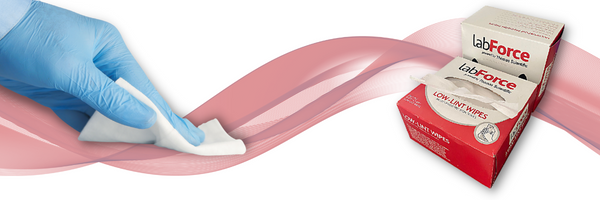
If you find yourself dealing with delicate tasks in a laboratory setting, you need the right tools to ensure that your job is done well. These wipes are designed to be perfect for any sensitive job in the laboratory, drafting room, clinic, or any electronic application because of their anti-static film cover that prevents the accumulation and production of dust. A lot of research, precision, and care goes into laboratory work. It’s no wonder that scientists and medical professionals require the best tools at their disposal in order to get the job done right. That’s why we created labForce® low-lint delicate task wipes—a tool designed specifically with sensitivity in mind. Let’s take a closer look at these wipes and how they can help you get the job done right.
Features of Low Lint Delicate Task Wipes
These wipes come in a pop-up box, making them easy to use and store. They are single-ply, which allows for greater accuracy and control when cleaning or wiping down delicate surfaces. But what sets these wipes apart from other lab wipers is the anti-static film cover that prevents accumulation and production of dust. This makes them perfect for the most sensitive jobs in the laboratory, the drafting room, the clinic, or any electronic applications where dust particles can ruin a project or contaminate a sample.
More Than Just Wipers
These low-lint delicate task wipes are not just great for cleaning surfaces either; they also come with a variety of uses beyond wiping down tables and equipment. With their anti-static film cover, they make great covers for sensitive electronics such as computer keyboards or server racks while also protecting against dust accumulation—something traditional cloth covers can’t do! In addition, these wipes are also ideal for cleaning up spills due to their absorbency; this means you don’t have to worry about getting your hands dirty while picking up liquids on hard surfaces.
Uses for Low Lint Delicate Task Wipes
Low-lint delicate task wipes are incredibly versatile when it comes to use cases in laboratories or medical settings. They can be used to clean delicate surfaces such as computer screens or camera lenses as well as removing dirt from hard surfaces such as countertops or microscopes. They can also be effectively used to clean medical instruments or remove the excess cleaning solution from surfaces after they have already been wiped down. Additionally, these wipes are ideal for absorbing spills on any surface without leaving behind a residue or causing static buildup on electronics.
Low-lint delicate task wipes from labForce® offer an easy way to keep your laboratory clean while ensuring that no dust particles accumulate on sensitive equipment or materials. With their 100% polyester knit fabric construction, they provide maximum absorbency with minimal residue left behind while still being compatible with many common solvents and cleansers used in labs and medical settings. Whether you’re wiping down a microscope lens or cleaning up a spill on a countertop, these task wipes will do the job quickly and effectively every time!